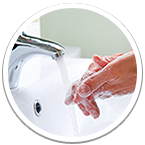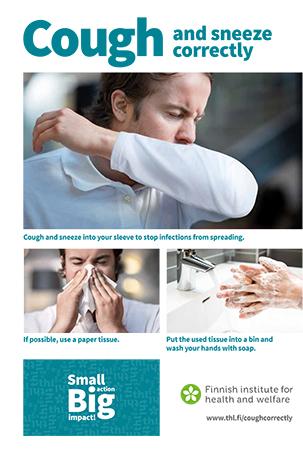Preventing respiratory tract infections
Respiratory tract infections are transmitted through droplets and air when a sick person coughs, sneezes, speaks, sings or shouts. They can also be spread through touch, if the infected person has coughed in his hands, for example, and later touches another person. Viruses can also be transmitted from surfaces, such as door handles.
Respiratory tract infections can be prevented in many ways. We recommend that you:
Get the recommended coronavirus and influenza vaccinations
A vaccination offers the best protection against influenza and severe coronavirus disease.
Stay at home while sick
If you fall ill, stay at home until the symptoms have clearly decreased and the temperature is gone. This usually takes 3-5 days. If you are sick and have to go outside your home, you can wear a mask if you wish.
Self-treatment of respiratory tract infections (Terveyskylä, in Finnish)
Wash your hands, cough and sneeze into your sleeve
Wash your hands frequently with water and soap. Make sure that you wash your hands for at least 20 seconds each time.
It is especially important to wash your hands:
- when you come in from outside
- before cooking and eating
- after using the toilet
- after coughing, sneezing or blowing your nose
- after touching surfaces that have been touched by a person with flu symptoms.
Also remember to dry your hands properly. Change hand towels frequently at home and have a separate hand towel for each family member. Outside the home after washing, dry your hands thoroughly, either in a disposable paper towel or in a clean, dry roller towel.
If you cannot wash your hands, use an alcohol-based or other hand rinse approved by the chemical authority.
Do not touch your eyes, nose or mouth unless you have just washed your hands.
Cough and sneeze into a disposable tissue and put the tissue in the bin immediately after use. If you do not have a tissue, cough or sneeze into your sleeve, not into your hands.
If you seek examinations and treatment at a health care institution due to respiratory tract symptoms, you can wear a mask if you wish. This protects staff and other patients from infection if you cough and sneeze.
Assess your own risk, use a mask if necessary and keep a distance from others
A face mask will prevent droplets from spreading into the environment. When you use a face mask, you protect others from infection. Keeping distance helps to protect both yourself and other people, such as those in risk groups, from infection.
If you have to move outside the home when you are ill, you can wear a mask if you wish and, if possible, keep a distance, especially in public indoor areas and transport.
A mask also protects the person wearing it to some degree.
Information on face masks, surgical masks and respirators (Finnish Institute of Occupational Health)
Take care of ventilation
Viruses are most easily spread in confined, closed areas with a large number of people and poor ventilation.
Communication material on preventing respiratory tract infections
Videos of hand washing and coughing
Posters of hand washing and coughing
How to protect yourself from influenza and coronavirus materials
Our material bank contains related material for social media and digital screens. Material is available in Finnish, Swedish and English.
Protect yourself from influenza and coronavirus
According to section 7 of the Infectious Diseases Act, THL acts as a national specialist institution for the prevention of communicable diseases and provides instructions to the population to avoid infection and prevent the spread of the disease. The guidelines issued by THL are recommendations and there is no legal obligation to comply with them.






